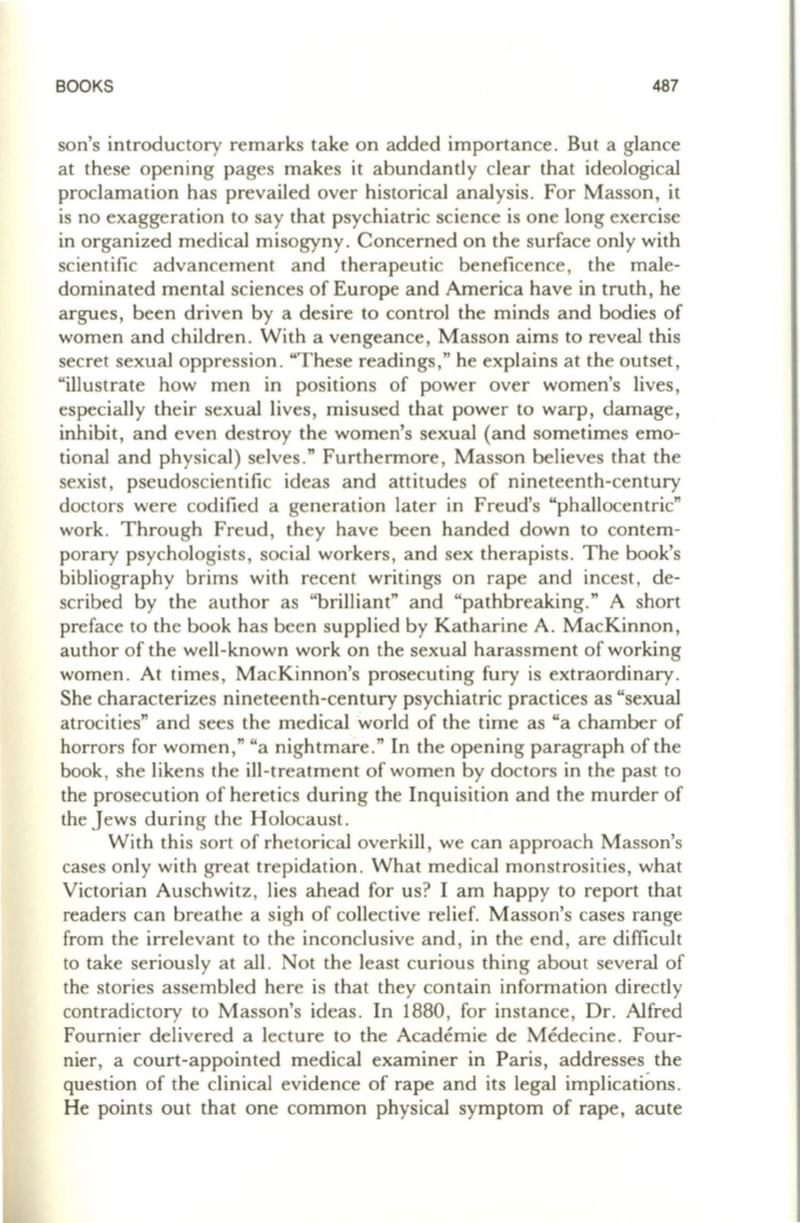
BOOKS
487
son's introductory remarks take on added importance. But a glance
at these opening pages makes it abundantly clear that ideological
proclamation has prevailed over historical analysis. For Masson, it
is no exaggeration to say that psychiatric science is one long exercise
in organized medical misogyny. Concerned on the surface only with
scientific advancement and therapeutic beneficence, the male–
dominated mental sciences of Europe and America have in truth, he
argues, been driven by a desire to control the minds and bodies of
women and children. With a vengeance, Masson aims to reveal this
secret sexual oppression. "These readings," he explains at the outset,
"illustrate how men in positions of power over women's lives,
especially their sexual lives, misused that power to warp, damage,
inhibit, and even destroy the women's sexual (and sometimes emo–
tional and physical) selves." Furthermore, Masson believes that the
sexist, pseudoscientific ideas and attitudes of nineteenth-century
doctors were codified a generation later in Freud's "phallocentric"
work. Through Freud, they have been handed down to contem–
porary psychologists, social workers, and sex therapists. The book's
bibliography brims with recent writings on rape and incest, de–
scribed by the author as "brilliant" and "pathbreaking." A short
preface to the book has been supplied by Katharine
A.
MacKinnon,
author of the well-known work on the sexual harassment of working
women. At times, MacKinnon's prosecuting fury is extraordinary.
She characterizes nineteenth-century psychiatric practices as "sexual
atrocities" and sees the medical world of the time as "a chamber of
horrors for women," "a nightmare." In the opening paragraph of the
book, she likens the ill-treatment of women by doctors in the past to
the prosecution of heretics during the Inquisition and the murder of
the Jews during the Holocaust.
With this sort of rhetorical overkill, we can approach Masson's
cases only with great trepidation. What medical monstrosities, what
Victorian Auschwitz, lies ahead for us? I am happy to report that
readers can breathe a sigh of collective relief. Masson's cases range
from the irrelevant to the inconclusive and, in the end, are difficult
to take seriously at all. Not the least curious thing about several of
the stories assembled here is that they contain information directly
contradictory to Masson's ideas . In 1880, for instance, Dr. Alfred
Fournier delivered a lecture to the Academie de Medecine. Four–
nier, a court-appointed medical examiner in Paris, addresses the
question of the clinical evidence of rape and its legal implications.
He points out that one common physical symptom of rape, acute


